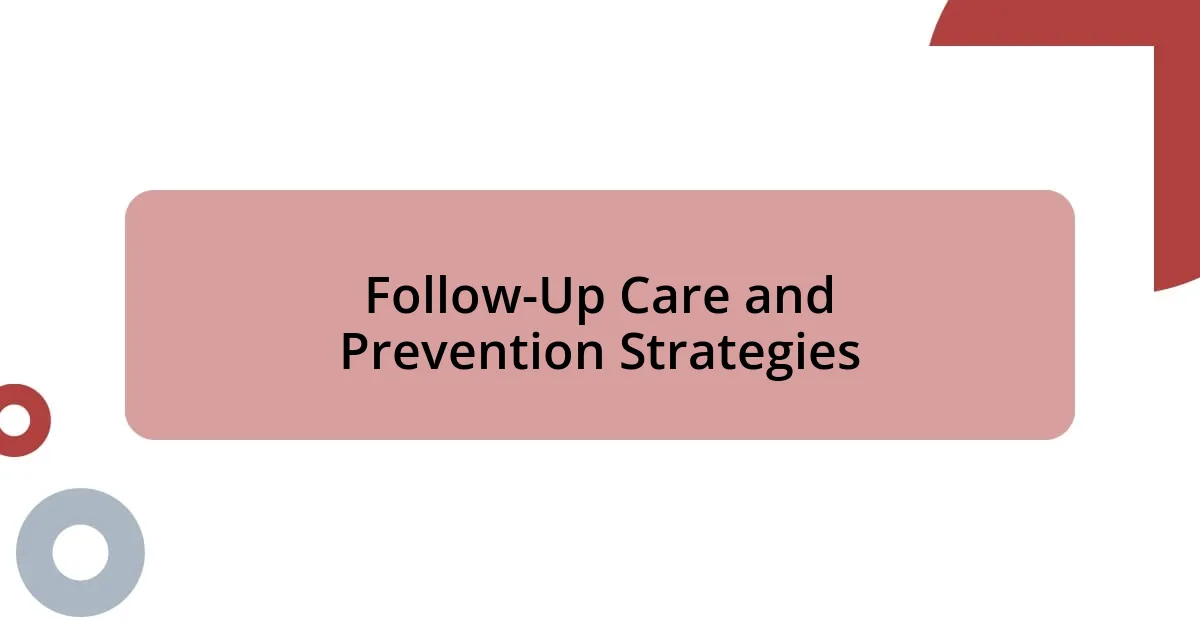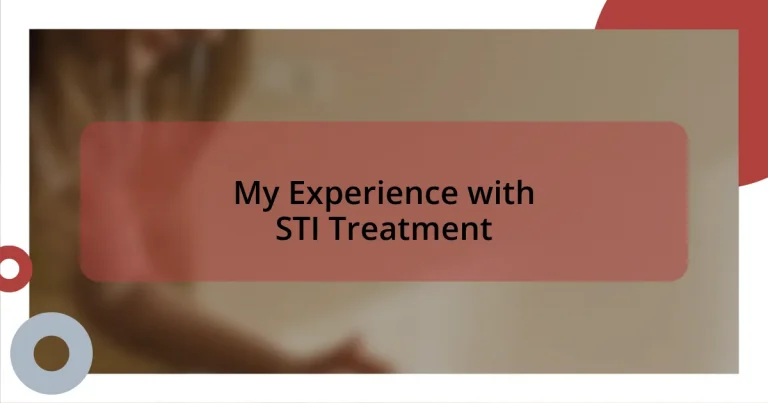Key takeaways:
- STIs have significant emotional and relational impacts, often leading to stigma and fear of seeking help.
- Recognizing symptoms and seeking medical help can empower individuals to take control of their health.
- Understanding treatment options, including the importance of completing courses and managing side effects, is essential for recovery.
- Follow-up care and proactive prevention strategies are crucial for long-term sexual health and reducing the spread of STIs.

Understanding STIs and Their Impact
Sexually transmitted infections (STIs) are more common than many people realize, and their scope is much broader than just physical symptoms. When I first learned about STIs, it was overwhelming; I remember feeling a mix of fear and confusion. Can you imagine the emotional toll they can take, not just on physical health but also on relationships and self-esteem?
The impact of STIs extends beyond the individual; it can ripple through households and communities. I recall a friend who faced stigma after being diagnosed with an STI, which not only affected her mental health but also strained her friendships. It made me wonder—how much does fear of judgment keep people from seeking help or discussing their experiences openly?
Understanding STIs also means recognizing their long-term effects. Some infections, like chlamydia and gonorrhea, can lead to severe complications if left untreated. This realization hit me hard when I heard stories of individuals who faced infertility or chronic pain due to a lack of awareness and timely treatment. It raises a crucial question: how can we better educate ourselves and those around us to break this cycle of misunderstanding?

My Symptoms and Initial Concerns
When I first noticed something felt off, it was hard to ignore. The symptoms crept in subtly—a tingling sensation that wouldn’t go away, accompanied by discomfort that made it difficult to focus on anything else. I found myself feeling vulnerable, grappling with what these signs could mean.
- Unusual discharge that seemed out of the ordinary.
- Burning sensation during urination.
- Pain during intercourse, which I had never experienced before.
- Swollen lymph nodes that added to my anxiety.
As I wrestled with these concerns, a swirl of emotions filled my mind—fear, shame, and a deep sense of uncertainty about what steps to take next. I remember pacing around my apartment, contemplating whether to reach out for help or simply brush it off. It’s challenging to confront those feelings, especially when we’re taught to keep such matters private. The weight of potential judgment loomed over me, making it even harder to seek the support I desperately needed.

Seeking Medical Help for Treatment
Seeking medical help for STI treatment can be one of the most challenging steps to take. I remember standing in the clinic, my heart racing, feeling vulnerable yet hopeful. The thought of being judged by a healthcare provider was intimidating, but deep down, I knew that ignoring my symptoms would only exacerbate my situation. I took a deep breath, reminded myself of my health’s importance, and decided to prioritize my well-being over my fears.
When I finally did seek help, the experience was surprisingly reassuring. The healthcare professionals were understanding and compassionate, which made me feel at ease. They explained every step of the testing and treatment process, addressing my concerns with empathy. I realized that seeking medical attention was not a sign of weakness but an act of empowerment. It helped me regain control over my health story.
| Advantages of Seeking Help | Challenges of Seeking Help |
|---|---|
| Access to Professional Advice | Fear of Judgment |
| Timely Treatment | Embarrassment |
| Potential for Preventive Care | Uncertainty of Results |

Exploring Available Treatment Options
Exploring the available treatment options for STIs can feel overwhelming, but understanding them is crucial. When I faced my own diagnosis, I remember feeling like I was in a maze of information—antibiotics, antivirals, and more. At that moment, it struck me: how do we even begin to navigate these options? I learned that the type of infection really dictates the treatment. For instance, bacterial infections like chlamydia and gonorrhea are typically treated with antibiotics, which made sense to me, but it was the next steps that had me questioning everything.
As I delved deeper into my treatment plan, my healthcare provider explained how antiviral medications could manage viral STIs, which reassured me. Listening to them detail the importance of completing the full course of treatment to prevent resistance was a lightbulb moment. It was eye-opening to realize the responsibility I had in this journey—not just for my own health but also to protect others. Have you ever thought about how a simple prescription can lead to a massive shift in your life’s trajectory? That’s precisely how I felt when I finally embraced the idea of committing to my treatment.
Moreover, the emotional aspect of treatment was just as important as the medical side. In my experience, I found support groups and educational resources that provided a sense of community and understanding. Discovering that others shared similar stories not only validated my feelings but empowered me to take action. I often wondered—how can we break down stigma if we don’t share our experiences? Engaging in conversations about treatment options turned out to be a vital part of my healing process, highlighting both the path ahead and the connections I was building along the way.

Managing Side Effects During Treatment
Managing side effects during STI treatment can be a daunting aspect of the healing journey. I distinctly remember the nausea that hit me after starting my medication. At first, I thought it was just anxiety, but it was very real. I quickly learned to keep some ginger tea close by—ginger worked wonders for my stomach and helped settle those uneasy feelings. What small adjustments can you make to ease your own discomfort during treatment?
Sometimes, the emotional side effects can be just as challenging as the physical ones. I felt moments of frustration and sadness wash over me, particularly when I experienced fatigue on days I wanted to feel energetic and active. To combat this, I leaned into self-care more than ever, indulging in comforting activities like reading a good book or enjoying a warm bath. It was essential for me to nurture my mental health, reminding myself that both my body and mind needed support. Have you ever found solace in simple pleasures during tough times?
Additionally, communication with my healthcare provider proved invaluable. They helped me navigate the side effects by adjusting my treatment when necessary and providing practical advice to mitigate discomfort. I remember calling with concerns about skin rashes, and their prompt response calmed my worries. It became clear that being proactive in communicating my experiences was crucial. I’ve learned that openness can transform how we manage our treatment journey—how do you envision partnering with your provider to enhance your own experience?

Follow-Up Care and Prevention Strategies
Follow-up care can be a game-changer after STI treatment. I vividly recall my first check-up post-treatment. I felt a mix of anxiety and relief; I needed reassurance that I was on the right track. My provider emphasized the importance of follow-up tests, especially for certain infections that might not show immediate symptoms. Having that conversation demystified the process and made me feel proactive.
Prevention strategies became a focal point in my healing journey. After my experience, I took those lessons to heart. I remember one conversation with a close friend who asked, “What steps are you taking to protect yourself moving forward?” It prompted me to reassess my own habits. I started prioritizing regular screenings and maintaining open discussions with partners about sexual health. It’s amazing how those small changes can lead to a more empowered approach to personal health.
Additionally, educating myself about safer practices was enlightening. I dove into resources about proper condom use and barrier methods, and I found it empowering to know I was taking control. Sharing this information with others felt rewarding—how often do we get to uplift our community through knowledge? Each time I talked about it, I couldn’t help but think about how awareness can create a ripple effect of prevention.












